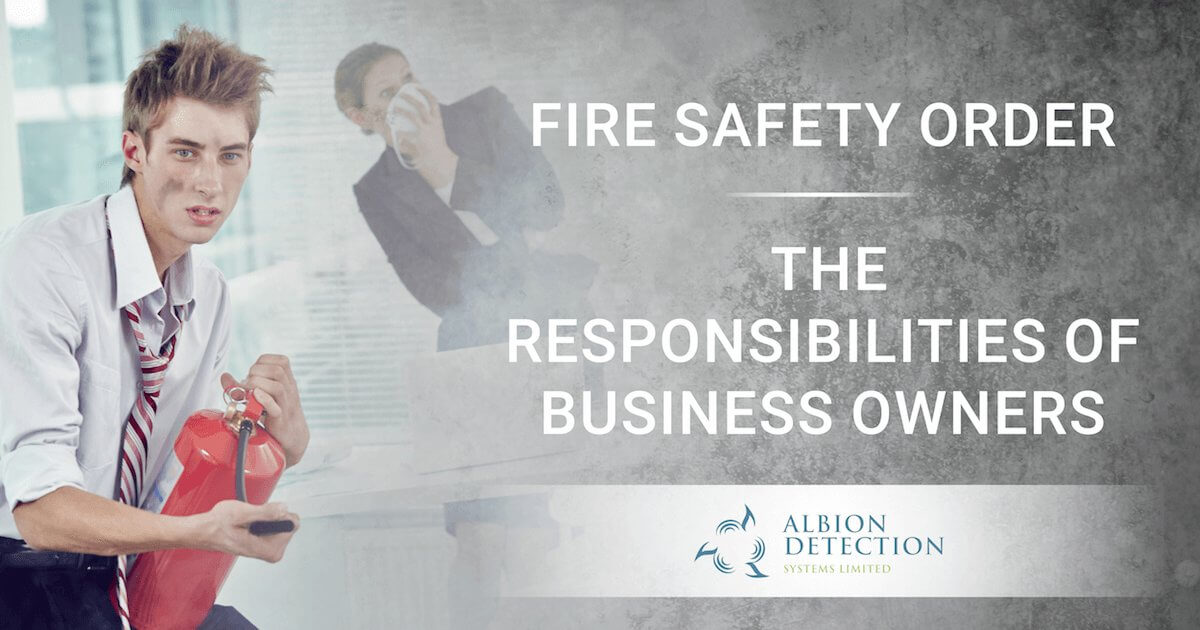
Fire Safety Order – The Responsibilities Of Business Owners – Albion Detection Systems
The Regulatory Reform Fire Safety Order 2005 that covers general fire safety in England and Wales is the benchmark standard for owners of commercial premises and under this law, carry a heavy burden of responsibility.
So when it comes to safeguarding their property against the risk of fire appointing a responsible person is a must.
Whilst reducing your fire risk is the responsibility of all staff when in practice, by law, this responsibility mainly lies with the property owner and manager.
Whatever the kind of commercial property, the occupiers are likely to simply presume your building is compliant with the latest health, safety and fire regulations – and it’s your sole responsibility as a business owner to ensure this is the case.
Fire Safety Order 2005
Breaching fire safety laws can mean serious consequences for your company – whether done intentionally through negligence or due to lack of fire safety know-how.
Keeping your building and its occupants safe at all times requires significant work and forward-planning.
Some of these elements are already present in the design of your building, in accordance with fire safety building regulation.
However differing premises have differing challenges, and older buildings, or those which cover a wide area or experience particularly heavy footfall, often experience even more stringent regulations and requirements in order to stay on the right side of the law.
Find Out What Your Responsibilities Are
First and foremost, there are a number of elements which can and should be incorporated into your building’s design following the completion of your fire risk assessment.
These include crucial design features such as fire doors, fire extinguishers and fire alarms.
The number and complexity of these arrangements, and your need for further measures (such as sprinkler systems), will be dictated by each individual building, so calling upon experienced professionals is always advisable during the planning stage.

Start With Risk Identification
Identifying risks is pivotal to putting the right measures in place to counter them.
This comes from a thorough knowledge and understanding of your building.
Identifying these risks (as well as subsequently reducing them) falls to the designated responsible person, assigned with the task of conducting your fire risk assessment and maintaining your fire safety checklist.
You will need to take into account all possible fire risks on the premises, from simple things like storing flammables too close to heat sources, to more complex dangers relating from the structural design of the building.
You need to be able to understand how a fire could start, identifying potential sources of ignition throughout.
Identifying risks also involves identifying who and what would be at risk in the event of a fire, including any vulnerable parties whose needs may have to be catered for with care.
This often includes children, the disabled and elderly, or in the case of some warehouses and specialist environments, those who encounter flammable materials as part of their work on site.
The Risk Reduction Focus
After identifying risk, the next responsibility of the building owner is to ascertain how to reduce these risks.
By analysing where the risk lies, you are well on your way to ensuring these risk factors don’t transform into a real and present danger.
A healthy risk assessment and risk reduction strategy minimises risk to the lowest manageable levels.
In practice, this will involve both small and large measures, such as checking your emergency exits are clear from obstruction daily, conducting regular fire alarm maintenance, and ensuring technically-led checks are carried out on a monthly, six-monthly and yearly basis, dependent upon the complexity of your own fire safety provisions.
Emergency Provisions
Fires are never expected, and so your emergency exit plan must be set in stone.
Even if you think you have everything in order, there is almost invariably room for improvement.
If you wonder how many fire drills are required by law, the answer is at least once a year – any more than this and they may start to lose their power; any less than this and you are contravening UK fire safety legislation.
Fire escape routes regulation can take a while to master, and often require revision – fire drills are immensely useful for ensuring this. Both staff and the building itself need to be well-equipped for handling fire quickly and efficiently and evacuating the premises without incident.
Again, this in part is linked to a clear exit point in event of a fire, alongside key features such as emergency signage, effective emergency lighting to show the way, and fire-resistant features to help prevent the fire from spreading further, keeping everyone out of harm’s way.
Staff Fire Safety Training
While the legal responsibility for your fire safety falls to the building owner and your designated responsible person (often the same person), all members of staff should have the necessary knowledge and skills to deal with a fire.
This will include basic training in everything from understanding what to do if and when they identify a fire, to procedures for raising the alarm and what follows.
Your fire drill procedure will help instil this, but you could also opt for regular training sessions and workshops to strengthen procedural knowledge across the workforce.
Maintenance Check Schedules Of Fire Systems
It is the responsibility of the building owner to ensure all fire protection systems and firefighting materials are maintained to the highest standard.
As mentioned earlier, this will include a variety of fire maintenance checks on a regular basis and with varying levels of thoroughness.
Whilst your daily maintenance checks will likely be straightforward and simple, checking the positioning of fire doors, briefly checking all fire alarms are operational, and ensuring spaces are free from obstruction.
Your weekly, monthly, six-monthly and yearly maintenance checks will be more complicated.
Some you can conduct yourself, but others will require the assistance of an accredited professional.
This may be your fire alarm installation team, who will have a first-hand knowledge of your company’s system and requirements.
If you have a sprinkler system fitted, this will require yearly maintenance checks.
Whilst more advanced forms of a fire alarm (such as those which utilise wireless connectivity) will need monthly and six-monthly testing by trained professionals.
As well as ensuring your company is securely safeguarded against the risk of fire, regular fire alarm maintenance check also ensure you are fulfilling your fire safety obligations as the building or business owner.
Ready To Get Fire Protection Focussed?
Want more expert advice on fulfilling your fire protection responsibilities?, Download our FREE Fire System Audit Checklist for business owners to get the inside track on where to start, or contact us to find out more, or book your free no obligation Fire Protection Consultation



